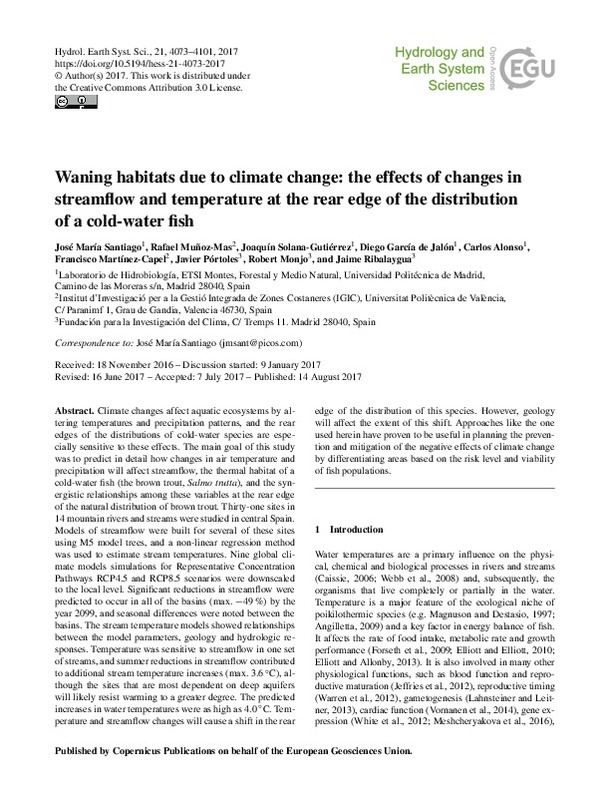JavaScript is disabled for your browser. Some features of this site may not work without it.
Buscar en RiuNet
Listar
Mi cuenta
Estadísticas
Ayuda RiuNet
Admin. UPV
Waning habitats due to climate change: effects of streamflow and temperature changes at the rear edge of the distribution of a cold-water fish
Mostrar el registro sencillo del ítem
Ficheros en el ítem
| dc.contributor.author | Santiago, J.M.
|
es_ES |
| dc.contributor.author | Muñoz Mas, Rafael
|
es_ES |
| dc.contributor.author | Solana-Gutierrez, J.
|
es_ES |
| dc.contributor.author | García de Jalón Lastra, Diego M.
|
es_ES |
| dc.contributor.author | Alonso, C.
|
es_ES |
| dc.contributor.author | Martinez-Capel, Francisco
|
es_ES |
| dc.contributor.author | Pórtoles, Javier
|
es_ES |
| dc.contributor.author | Monjo, Robert
|
es_ES |
| dc.contributor.author | Ribalaygua, J.
|
es_ES |
| dc.date.accessioned | 2018-05-19T04:25:15Z | |
| dc.date.available | 2018-05-19T04:25:15Z | |
| dc.date.issued | 2017 | es_ES |
| dc.identifier.issn | 1812-2108 | es_ES |
| dc.identifier.uri | http://hdl.handle.net/10251/102263 | |
| dc.description.abstract | [EN] Climate changes affect aquatic ecosystems by altering temperatures and precipitation patterns, and the rear edges of the distributions of cold-water species are especially sensitive to these effects. The main goal of this study was to predict in detail how changes in air temperature and precipitation will affect streamflow, the thermal habitat of a cold-water fish (the brown trout, Salmo trutta), and the synergistic relationships among these variables at the rear edge of the natural distribution of brown trout. Thirty-one sites in 14 mountain rivers and streams were studied in central Spain. Models of streamflow were built for several of these sites using M5 model trees, and a non-linear regression method was used to estimate stream temperatures. Nine global climate models simulations for Representative Concentration Pathways RCP4.5 and RCP8.5 scenarios were downscaled to the local level. Significant reductions in streamflow were predicted to occur in all of the basins (max. ¿49¿%) by the year 2099, and seasonal differences were noted between the basins. The stream temperature models showed relationships between the model parameters, geology and hydrologic responses. Temperature was sensitive to streamflow in one set of streams, and summer reductions in streamflow contributed to additional stream temperature increases (max. 3.6¿°C), although the sites that are most dependent on deep aquifers will likely resist warming to a greater degree. The predicted increases in water temperatures were as high as 4.0¿°C. Temperature and streamflow changes will cause a shift in the rear edge of the distribution of this species. However, geology will affect the extent of this shift. Approaches like the one used herein have proven to be useful in planning the prevention and mitigation of the negative effects of climate change by differentiating areas based on the risk level and viability of fish populations. | es_ES |
| dc.description.sponsorship | We are grateful to the Consejería de Medio Ambiente y O.T. of the Government of Castilla y León, especially to Mariano Anchuelo, Fabián Mateo and the forest ranger team of Navafría. Also, we are indebted to the Sierra of Guadarrama National Park staff, and especially with Juan Bielva and Ángel Rubio for the temperature data of Lozoya stream. Juan Diego Alcaraz is the author of the temperature data of the Ebrón Basin. Valérie Ouellet and two anonymous referees provided valuable comments that substantially improved the original manuscript. The World Climate Research Programme’s Working Group on Coupled Modelling is responsible for the 5th Coupled Model Intercomparison Project, and we thank the climate modelling groups for producing and making available their model output. Climate change study was partially funded by the Ministerio de Agricultura, Alimentación y Medio Ambiente of Spain through the Fundación para la Investigación del Clima (http://www.ficlima.org/); by the European Union, DG for Environment (DURERO project. C1.3913442); by the Ministerio de Economía y Competitividad of Spain (IMPADAPT project CGL2013-48424-C2-1-R); and by FEDER funds of the European Commission | |
| dc.language | Inglés | es_ES |
| dc.publisher | Copernicus Publications | es_ES |
| dc.relation.ispartof | Hydrology and Earth System Sciences Discussions | es_ES |
| dc.rights | Reconocimiento (by) | es_ES |
| dc.subject.classification | TECNOLOGIA DEL MEDIO AMBIENTE | es_ES |
| dc.title | Waning habitats due to climate change: effects of streamflow and temperature changes at the rear edge of the distribution of a cold-water fish | es_ES |
| dc.type | Artículo | es_ES |
| dc.identifier.doi | 10.5194/hess-2016-606 | es_ES |
| dc.relation.projectID | info:eu-repo/grantAgreement/MINECO//CGL2013-48424-C2-1-R/ES/ADAPTACION AL CAMBIO GLOBAL EN SISTEMAS DE RECURSOS HIDRICOS/ | es_ES |
| dc.rights.accessRights | Abierto | es_ES |
| dc.contributor.affiliation | Universitat Politècnica de València. Instituto de Investigación para la Gestión Integral de Zonas Costeras - Institut d'Investigació per a la Gestió Integral de Zones Costaneres | es_ES |
| dc.contributor.affiliation | Universitat Politècnica de València. Departamento de Ingeniería Hidráulica y Medio Ambiente - Departament d'Enginyeria Hidràulica i Medi Ambient | es_ES |
| dc.description.bibliographicCitation | Santiago, J.; Muñoz Mas, R.; Solana-Gutierrez, J.; García De Jalón Lastra, DM.; Alonso, C.; Martinez-Capel, F.; Pórtoles, J.... (2017). Waning habitats due to climate change: effects of streamflow and temperature changes at the rear edge of the distribution of a cold-water fish. Hydrology and Earth System Sciences Discussions. 21:4073-4101. https://doi.org/10.5194/hess-2016-606 | es_ES |
| dc.description.accrualMethod | S | es_ES |
| dc.relation.publisherversion | http://doi.org/10.5194/hess-2016-606 | es_ES |
| dc.description.upvformatpinicio | 4073 | es_ES |
| dc.description.upvformatpfin | 4101 | es_ES |
| dc.type.version | info:eu-repo/semantics/publishedVersion | es_ES |
| dc.description.volume | 21 | es_ES |
| dc.relation.pasarela | S\347886 | es_ES |
| dc.contributor.funder | Ministerio de Economía, Industria y Competitividad | es_ES |








